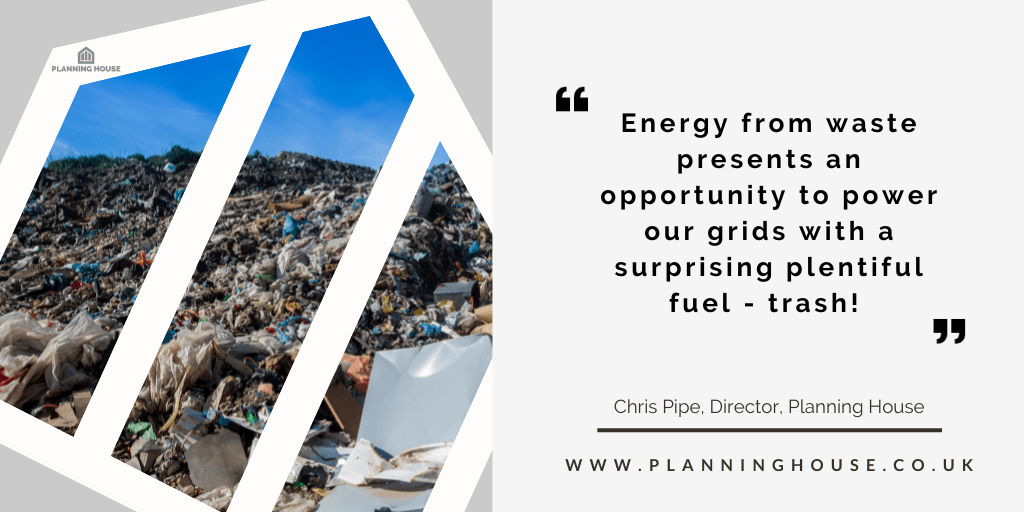As the UK seeks renewable alternatives to fossil fuels, Energy from Waste (EfW) presents an opportunity to power our grids with a surprising fuel – waste! By incinerating non-recyclable waste, EfW facilities generate renewable heat and power. But progress requires savvy site selection and community approval.
The UK has a long history of Energy from Waste, with the first EfW plant opening in the 1970s. Today, there are over 200 EfW plants in the UK, which generate enough electricity to power over 2 million homes.
There are a few main types of Energy from Waste projects:
- Mass Burn Incineration: The most common method which involves directly burning mixed municipal solid waste on grates to generate electricity. Relatively efficient but can produce air pollution and contribute to climate change if not controlled.
- Gasification: Converts waste into a syngas through thermal breakdown in a low-oxygen environment which can then be used to generate electricity or heat. More efficient than incineration and fewer emissions, but more expensive to develop and operate.
- Pyrolysis: Thermally degrades waste in the absence of oxygen to produce a bio-oil that can be burned for energy. Offers efficiencies over incineration with lower emissions, but development and operation costs are higher.
- Anaerobic Digestion: Breaks down biodegradable waste through microbial action to produce a biogas consisting mainly of methane, which can be combusted for on-site power. A proven method that diverts waste from landfills but the process emissions include methane.
- Leachate Treatment: Critical process to treat wastewater from EfW facilities through specialised infrastructure in order to protect the environment, albeit at a cost.
- Refuse-Derived Fuel Plants: Mixed waste is processed into a dense fuel that can replace coal in power stations or industrial kilns like cement plants.
- Co-Processing: Utilises treated waste materials as supplemental fuels in coal or industrial thermal processes.
- Small-Scale Systems: Localised facilities using gasification, pyrolysis or digestion suitable for smaller volumes of waste.
Of course, EfW also has critics regarding emissions and aesthetics. But with best practices, these issues can be addressed for results everyone can feel good about. So what’s the pros and cons…
Pros:
- Renewable energy production – Generates electricity and heat from non-recyclable waste feedstock, providing low-carbon alternative to fossil fuels.
- Waste management solution – Diverts biodegradable municipal waste from landfills, reducing methane emissions that contribute to climate change.
- Baseload power source – As waste will always be produced, energy from waste plants can operate continuously unlike solar/wind.
- Local job creation – New facilities support jobs in plant operation, waste collection, power distribution and plant engineering/assembly.
Cons:
- Public perception – Some communities oppose hosting waste facilities over concerns about emissions, traffic and impacts on amenity/property values.
- High capital cost – Building energy from waste plants requires substantial upfront investment compared to other renewable options.
- Air emissions – Even with abatement systems, facilities release negligible levels of pollutants like heavy metals, dioxins which require monitoring.
- Ash handling – Processing waste leaves ash residues that require treatment and disposal, some of which can be hazardous waste.
Key revenue streams for Energy from Waste projects include:
- Power/heat sales – Income from selling electricity and steam generated to nearby industry/buildings via heat networks. Typically secure via power purchase agreements.
- Tipping/gate fees – Facilities earn revenue each time a waste collection vehicle discharges its load. Fees are paid by local authorities/waste companies.
- Government incentives – In the UK, projects may qualify for payments through the Renewables Obligation certificate scheme or Contracts for Difference scheme.
- RECs/LECs – Renewable energy certificates or low-carbon energy certificates are earned for each MWh of renewable power generated and can be sold to offset carbon elsewhere.
- Carbon credits – Waste-to-energy reduces reliance on landfill gas, generating verified emission reduction credits under schemes like EU ETS that have market value.
- Ash sales – Non-hazardous ash byproducts from the combustion process can sometimes be utilized in cement/construction if meeting quality standards.
- Grants/funding – Development costs may be partially supported through regional economic development or innovation grant programs.
Diversifying revenue streams through stacked incentive programs and long-term off-take agreements helps maximise the financial viability of waste-to-energy infrastructure projects.
Town Planning Implications
Some of the key town planning implications to consider for energy from waste projects include:
- Site Selection – Suitable sites need to be large enough to house the facility and be located near waste sources and grid connections. Compatibility with surrounding land uses is important.
- Traffic Impacts – Additional traffic from waste delivery vehicles needs to be assessed. Potential congestion or overuse of minor roads should be mitigated.
- Visual & Noise Impacts – Large facilities can cause concern about impacts on landscapes and residential amenity. Sensitive site design and buffer zones may be required.
- Air Quality & Odour – Emissions to air need to be rigorously controlled and monitored to strict standards. Odour issues also require local authority approval.
- Water Management – Surface runoff and wastewater from the site needs sustainable drainage/treatment to avoid pollution.
- Biodiversity – Potential impacts on habitats need evaluation and mitigation such as green infrastructure.
- Decommissioning – Long-term plans are required to ensure the site can be restored once operations cease.
- Energy Use & Grid Connection – Export of electricity may require local grid upgrades to be agreed with providers.
Ultimately, the decision of whether or not to use energy from waste is a complex one that should be made on a case-by-case basis, taking into account all of the factors involved.
Related Content
You might find our article Decentralised Energy interesting.
One of our clients, J&B Recycling, have also written a good article: What is Energy from Waste (EfW)
We’ve created a collection of articles on Energy! Knowledge is power and sharing information is something we feel passionate about.
If you need support with your Energy project or any other town planning issue feel free to contact us.


